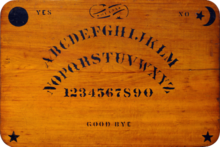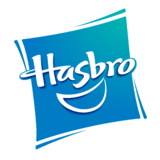Ouija
The ouija (/ˈwiːdʒə/ WEE-jə, /-dʒi/ jee), also known as a spirit board or talking board, is a flat board marked with the letters of the alphabet, the numbers 0–9, the words "yes", "no", occasionally "hello" and "goodbye", along with various symbols and graphics. It uses a planchette (small heart-shaped piece of wood or plastic) as a movable indicator to spell out messages during a séance. Participants place their fingers on the planchette, and it is moved about the board to spell out words. "Ouija" is a trademark of Hasbro,[1] but is often used generically to refer to any talking board.
| Part of a series on |
| Spiritualism |
|---|
|
Main articles |
|
Practices |
|
|
Spiritualists believed that the dead were able to contact the living and reportedly used a talking board very similar to a modern Ouija board at their camps in Ohio in 1886 to ostensibly enable faster communication with spirits.[2] Following its commercial introduction by businessman Elijah Bond on July 1, 1890,[1] the Ouija board was regarded as an innocent parlor game unrelated to the occult until American spiritualist Pearl Curran popularized its use as a divining tool during World War I.[3]
Paranormal and supernatural beliefs associated with Ouija have been criticized by the scientific community and are characterized as pseudoscience. The action of the board can be parsimoniously explained by unconscious movements of those controlling the pointer, a psychophysiological phenomenon known as the ideomotor effect.[4][5][6][7]
Some Christian denominations have "warned against using Ouija boards", holding that they can lead to demonic possession.[8][9] Occultists, on the other hand, are divided on the issue, with some saying that it can be a tool for positive transformation; others reiterate the warnings of many Christians and caution "inexperienced users" against it.[8]
History
Precursors
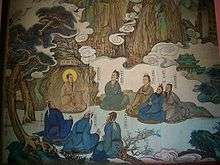
One of the first mentions of the automatic writing method used in the ouija board is found in China around 1100 AD, in historical documents of the Song Dynasty. The method was known as fuji "planchette writing". The use of planchette writing as an ostensible means of necromancy and communion with the spirit-world continued, and, albeit under special rituals and supervisions, was a central practice of the Quanzhen School, until it was forbidden by the Qing Dynasty.[10] Several entire scriptures of the Daozang are supposedly works of automatic planchette writing. According to one author, similar methods of mediumistic spirit writing have been practiced in ancient India, Greece, Rome, and medieval Europe.[11]
Talking boards
As a part of the spiritualist movement, mediums began to employ various means for communication with the dead. Following the American Civil War in the United States, mediums did significant business in presumably allowing survivors to contact lost relatives. The ouija itself was created and named in Baltimore, Maryland, in 1890, but the use of talking boards was so common by 1886 that news reported the phenomenon taking over the spiritualists' camps in Ohio.[12]
Commercial parlor game
Businessman Elijah Bond had the idea to patent a planchette sold with a board on which the alphabet was printed, much like the previously existing talking boards. Bond filed on May 28, 1890 for patent protection and thus is credited with the invention of the Ouija board. Issue date on the patent was February 10, 1891. He received U.S. Patent 446,054. Bond was an attorney and was an inventor of other objects in addition to this device.
An employee of Elijah Bond, William Fuld, took over the talking board production. In 1901, Fuld started production of his own boards under the name "Ouija".[13] Charles Kennard (founder of Kennard Novelty Company which manufactured Fuld's talking boards and where Fuld had worked as a varnisher) claimed he learned the name "Ouija" from using the board and that it was an ancient Egyptian word meaning "good luck." When Fuld took over production of the boards, he popularized the more widely accepted etymology: that the name came from a combination of the French and German words for "yes".[14]
The Fuld name became synonymous with the Ouija board, as Fuld reinvented its history, claiming that he himself had invented it. The strange talk about the boards from Fuld's competitors flooded the market, and all these boards enjoyed a heyday from the 1920s.
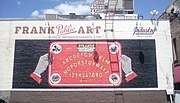 Ouija board painted on a two story building in downtown Austin, Texas
Ouija board painted on a two story building in downtown Austin, Texas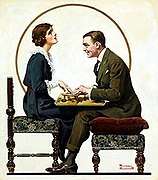 Norman Rockwell painting of a couple using a Ouija board (1920)
Norman Rockwell painting of a couple using a Ouija board (1920)
Trade marks and patents
- Trade-Mark Registration: "Ouija" (Trademark no. 18,919; 3 February 1891: Kennard Novelty Company)
- "Ouija or Egyptian Luck Board" (patent no. 446,054; 10 February 1891: Elijah J. Bond – assigned to Charles W. Kennard and William H. A. Maupin)
- "Talking-Board" (patent no. 462,819; 10 November 1891: Charles W. Kennard)
- "Game Apparatus" (patent no. 479,266: 19 July 1892: William Fuld)
- "Game Apparatus" (patent no. 619,236: 7 February 1899: Justin F. Simonds)
- "Ouija or Talking Board" (patent no. 1,125,833; 19 January 1915: William Fuld)
- "Design for the Movable Member of a Talking-Board" (patent no. D56,001; 10 August 1920: William Fuld)
- "Design of Finger-Rest and Pointer for a Game" (patent no. D56,085; 10 August 1920: John Vanderkamp – assigned to Goldsmith Publishing Company)
- "Message Interpreting Device" or "Psychic Messenger" (patent no. 1,352,046; 7 September 1920: Frederick H. Black)
- "Design for the Movable Member of a Talking-Board" (patent no. D56,001; 10 August 1920: William Fuld)
- "Ouija Board" (patent no. D56,449; 26 October 1920: Clifford H. McGlasson)
- "Psychic Game" (patent no. 1,370,249; 1 March 1921: Theodore H. White)
- "Ouija Board" (patent no. 1,400,791; 20 December 1921: Harry M. Bigelow)
- "Game Board" (patent no. 1,422,042; 4 July 1922: John R. Donnelly)
- "(Magnetic) Toy" (patent no. 1,422,775; 11 July 1922: Leon Martocci-Pisculli)
- "Psychic Instrument" (patent no. 1,476,158; 4 December 1923: Grover C. Haffner)
- "Game" (patent no. 1,514,260; 4 November 1924: Alfred A. Rees)
- "Amusement Device" (patent no. 1,870,677; 9 August 1932: William A. Fuld)
- "Amusement Device" (patent no. 2,220,455; 5 November 1940: John P. McCarthy)
- "Finger Pressure Actuated Message Interpreting Amusement Device" (patent no. 2,511,377; 13 June 1950: Raymond S. Richmond)
- "Message Device With Freely Swingable Pointer" (patent no. 3,306,617; 28 February 1967: Thomas W. Gillespie)
Scientific investigation
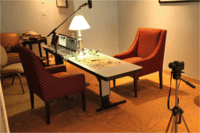
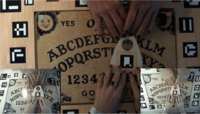
The ouija phenomenon is considered by the scientific community to be the result of the ideomotor response.[4][16][17][18] Michael Faraday first described this effect in 1853, while investigating table-turning.[19][20]
Various studies have been produced, recreating the effects of the ouija board in the lab and showing that, under laboratory conditions, the subjects were moving the planchette involuntarily.[16][21] A 2012 study found that when answering yes or no questions, ouija use was significantly more accurate than guesswork, suggesting that it might draw on the unconscious mind.[17] Skeptics have described ouija board users as 'operators'.[22] Some critics noted that the messages ostensibly spelled out by spirits were similar to whatever was going through the minds of the subjects.[23] According to professor of neurology Terence Hines in his book Pseudoscience and the Paranormal (2003):
The planchette is guided by unconscious muscular exertions like those responsible for table movement. Nonetheless, in both cases, the illusion that the object (table or planchette) is moving under its own control is often extremely powerful and sufficient to convince many people that spirits are truly at work ... The unconscious muscle movements responsible for the moving tables and Ouija board phenomena seen at seances are examples of a class of phenomena due to what psychologists call a dissociative state. A dissociative state is one in which consciousness is somehow divided or cut off from some aspects of the individual's normal cognitive, motor, or sensory functions.[24]
Ouija boards were already criticized by scholars early on, being described in a 1927 journal as "'vestigial remains' of primitive belief-systems" and a con to part fools from their money.[25] Another 1921 journal described reports of ouija board findings as 'half truths' and suggested that their inclusion in national newspapers at the time lowered the national discourse overall.[26]
In the 1970s ouija board users were also described as "cult members" by sociologists, though this was severely scrutinised in the field.[27]
Religious responses
Since early in the Ouija board's history, it has been criticized by several Christian denominations.[8] For example, Catholic Answers, a Roman Catholic Christian apologetics organization, states that "The Ouija board is far from harmless, as it is a form of divination (seeking information from supernatural sources)."[28] Moreover, Catholic Christian bishops in Micronesia called for the boards to be banned and warned congregations that they were talking to demons when using Ouija boards.[29] In a pastoral letter, The Dutch Reformed Churches encouraged its communicants to avoid Ouija boards, as it is a practice "related to the occult".[30] The Wisconsin Evangelical Lutheran Synod also forbids its faithful from using Ouija boards as it teaches that such would be a violation of the Ten Commandments.[31]
In 2001, Ouija boards were burned in Alamogordo, New Mexico, by fundamentalist groups alongside Harry Potter books as "symbols of witchcraft."[32][33][34] Religious criticism has also expressed beliefs that the Ouija board reveals information which should only be in God's hands, and thus it is a tool of Satan.[35] A spokesperson for Human Life International described the boards as a portal to talk to spirits and called for Hasbro to be prohibited from marketing them.[36]
These religious objections to use of the Ouija board have in turn given rise to ostension type folklore in the communities where they circulate. Cautionary tales that the board opens a door to evil spirits turn the game into the subject of a supernatural dare, especially for young people.[37]
Notable users
Literature
Ouija boards have been the source of inspiration for literary works, used as guidance in writing or as a form of channeling literary works. As a result of Ouija boards' becoming popular in the early 20th century, by the 1920s many "psychic" books were written of varying quality often initiated by ouija board use.[38]
- Emily Grant Hutchings claimed that her novel Jap Herron: A Novel Written from the Ouija Board (1917) was dictated by Mark Twain's spirit through the use of a Ouija board after his death.[39]
- Pearl Lenore Curran (1883–1937), alleged that for over 20 years she was in contact with a spirit named Patience Worth.
- This symbiotic relationship produced several novels, and works of poetry and prose, which Pearl Curran claimed were delivered to her through channelling Worth's spirit during sessions with a ouija board, and which works Curran then transcribed.
- Much of William Butler Yeats's later poetry was inspired, among other facets of occultism, by the Ouija board. Yeats himself did not use it, but his wife did.[40]
- In late 1963, Jane Roberts and her husband Robert Butts started experimenting with a ouija board as part of Roberts' research for a book on extra-sensory perception.[41]
- According to Roberts and Butts, on December 2, 1963 they began to receive coherent messages from a male personality ( an 'energy personality essence no longer focused in the physical world') who eventually identified himself as "Seth", culminating in a series of books dictated by "Seth".
- In 1982, poet James Merrill released an apocalyptic 560-page epic poem titled The Changing Light at Sandover, which documented two decades of messages dictated from the Ouija board during séances hosted by Merrill and his partner David Noyes Jackson.
- Sandover, which received the National Book Critics Circle Award in 1983,[42] was published in three volumes beginning in 1976. The first contained a poem for each of the letters A through Z, and was called The Book of Ephraim. It appeared in the collection Divine Comedies, which won the Pulitzer Prize for Poetry in 1977.[43] According to Merrill, the spirits ordered him to write and publish the next two installments, Mirabell: Books of Number in 1978 (which won the National Book Award for Poetry)[44] and Scripts for the Pageant in 1980.
Others
- Roland Doe used a Ouija board, which the Catholic Church stated led to his possession by a demon.[45]
- Dick Brooks, of the Houdini Museum in Scranton, Pennsylvania, uses a Ouija board as part of a paranormal and seance presentation.[46]
- G. K. Chesterton used a Ouija board in his teenage years.
- Around 1893, he had gone through a crisis of scepticism and depression, and during this period Chesterton experimented with the Ouija board and grew fascinated with the occult.[47]
- Bill Wilson, the co-founder of Alcoholics Anonymous, used a Ouija board and conducted seances in attempts to contact the dead.[48]
- Early press releases stated that Vincent Furnier's stage and band name "Alice Cooper" was agreed upon after a session with a Ouija board, during which it was revealed that Furnier was the reincarnation of a 17th-century witch with that name. Alice Cooper later revealed that he just thought of the first name that came to his head while discussing a new band name with his band.[49]
- Former Italian Prime Minister Romano Prodi claimed under oath that, in a séance held in 1978 with other professors at the University of Bologna, the "ghost" of Giorgio La Pira used a Ouija to spell the name of the street where Aldo Moro was being held by the Red Brigades.
- According to Peter Popham of The Independent: "Everybody here has long believed that Prodi's Ouija board tale was no more than an ill-advised and bizarre way to conceal the identity of his true source, probably a person from Bologna's seething far-left underground whom he was pledged to protect."[50]
- The Mars Volta wrote their album Bedlam in Goliath (2008) based on their alleged experiences with a Ouija board.
- According to their story (written for them by a fiction author, Jeremy Robert Johnson), Omar Rodriguez Lopez purchased one while traveling in Jerusalem. At first the board provided a story which became the theme for the album. Strange events allegedly related to this activity occurred during the recording of the album: the studio flooded, one of the album's main engineers had a nervous breakdown, equipment began to malfunction, and Cedric Bixler-Zavala's foot was injured. Following these bad experiences the band buried the Ouija board.[51]
- In the murder trial of Joshua Tucker, his mother insisted that he had carried out the murders while possessed by the Devil, who found him when he was using a Ouija board.[52][53]
- In London in 1994, convicted murderer Stephen Young was granted a retrial after it was learned that four of the jurors had conducted a Ouija board séance and had "contacted" the murdered man, who had named Young as his killer.[54] Young was convicted for a second time at his retrial and jailed for life.[55][56][57]
- E. H. Jones and C. W. Hill, whilst prisoners of the Turks during the First World War, used a Ouija board to convince their captors that they were mediums as part of an escape plan.[58]
Aleister Crowley
Aleister Crowley had great admiration for the use of the ouija board and it played a passing role in his magical workings.[59][60] Jane Wolfe, who lived with Crowley at Abbey of Thelema, also used the Ouija board. She credits some of her greatest spiritual communications to use of this implement. Crowley also discussed the Ouija board with another of his students, and the most ardent of them, Frater Achad (Charles Stansfeld Jones): it is frequently mentioned in their unpublished letters. In 1917 Achad experimented with the board as a means of summoning Angels, as opposed to Elementals. In one letter Crowley told Jones:
Your Ouija board experiment is rather fun. You see how very satisfactory it is, but I believe things improve greatly with practice. I think you should keep to one angel, and make the magical preparations more elaborate.
Over the years, both became so fascinated by the board that they discussed marketing their own design. Their discourse culminated in a letter, dated February 21, 1919, in which Crowley tells Jones,
Re: Ouija Board. I offer you the basis of ten percent of my net profit. You are, if you accept this, responsible for the legal protection of the ideas, and the marketing of the copyright designs. I trust that this may be satisfactory to you. I hope to let you have the material in the course of a week.
In March, Crowley wrote to Achad to inform him,"I'll think up another name for Ouija." But their business venture never came to fruition and Crowley's new design, along with his name for the board, has not survived. Crowley has stated, of the Ouija Board that,
There is, however, a good way of using this instrument to get what you want, and that is to perform the whole operation in a consecrated circle, so that undesirable aliens cannot interfere with it. You should then employ the proper magical invocation in order to get into your circle just the one spirit you want. It is comparatively easy to do this. A few simple instructions are all that is necessary, and I shall be pleased to give these, free of charge, to any one who cares to apply.[59]
In popular culture
Ouija boards have figured prominently in horror tales in various media as devices enabling malevolent spirits to spook their users. Most often, they make brief appearances, relying heavily on the atmosphere of mystery the board already holds in the mind of the viewer, in order to add credence to the paranormal presence in the story being told.
Books
In Arthur C. Clarke's novel Childhood's End, aliens from a distant star visit and oversee the Earth, and human users of a Ouija board spell out the name of their star, from the New General Catalogue. See The Golden Age.
In Stephen King's postapocalyptic novel The Stand, Nadine Cross is contacted by Randall Flagg (also known as the dark man or Satan's Imp) twice via Ouija board. The first time is unintentionally, in college; the second time, in post-plague Boulder, she deliberately opens herself up to the communication, with dire consequences.
The Ouija Board (Paranormal Adventure Series Book 1) by Shelby White centers on a group of friends who unintentionally release evil through their use of a Ouija board, as does The Harrowing by Alexandra Sokoloff.
In For What It's Worth by Janet Tashjian a boy uses a Ouija board to contact the spirits of Janis Joplin, Jimi Hendrix, and Jim Morrison.
Issue #79 of Bart Simpson, a comic book series based on The Simpsons, contains a story called "The Demon" in which Bart and Lisa find a Ouija board and unleash a demon. Issue #10 of Bart Simpson's Treehouse of horror contains the story "Scareway to Heaven" in which a Ouija board results in demon possession.
The Invisible Histories of the Spiral Mountain; or The Hymns of Melchizedek, an occult novel by Christopher of Detroit, contains several chapters that use the talking board for communication with the protagonist's higher self.
Movies
The Uninvited, made in 1944, features a scene with an impromptu board the characters put together. The 1973 blockbuster film, The Exorcist, also uses a Ouija board to explain why the young girl becomes possessed. Alison's Birthday has one too, with its claustrophobia-inducing filming, as do the films Deadly Messages and Awakenings.
The earliest Western film to hinge its entire plot around the (mis)use of a Ouija board, Witchboard (1986), makes a nod to The Exorcist (where there is a sequence in which a board is used), with a main character called Linda, and her partner quipping "So what you're telling me is ... that I'm living with Linda Blair?" Witchboard was so successful it spawned two sequels: Witchboard 2: The Devil's Doorway, and Witchboard III: The Possession. In the same year as the first of the trilogy, the film Spookies also had its own Ouija board scene.
In 13 Ghosts (1960), Cyrus Zorba's children play with a Ouija board and inadvertently learn about the titular ghosts.
What Lies Beneath (2000) also includes a séance scene with a board. Paranormal Activity (2007) involves a violent entity haunting a couple that becomes more powerful when the Ouija board is used. Another 2007 film, Ouija, depicted a group of adolescents whose use of the board causes a murderous spirit to follow them, while four years later, The Ouija Experiment portrayed a group of friends whose use of the board opens, and fails to close, a portal between the worlds of the living and the dead.[61] The 2014 film Ouija featured a group of friends whose use of the board prompted a series of deaths.[62] That film was followed by a 2016 prequel, Ouija: Origin of Evil, which also features the device.
I Am Zozo follows a group of people that run afoul of a demon (based on Pazuzu) after using a Ouija board.[63]
Television
In season 1 episode 5 of The West Wing, the Ouija boards are mentioned by two characters who compare having a Ouija board to believing in UFOs.
In Season 3 Episode 8 of the TV series Reba, Barbra Jean and Reba use an Ouija Board to try and clean Barbra Jean and Brock's house after Reba convinced her that the house was haunted. While holding the séance Reba pretended to be a ghost causing Barbra Jean to scream and run up stairs. The electricity then goes out and Barbra Jean screams once again. At the end of the episode Barbra Jean asked Reba if they should ask the board if Brock was being a good husband in Vegas and the planchette moved. Reba then jumped across the table into Barbra Jean's arms.
The National Geographic show Brain Games Season 5 episode "Paranormal" clearly showed the board did not work when all participants were blindfolded.[64]
In a Halloween special of The Goldbergs episode, "Jackie Likes Star Trek", Barry and his friends play with the board.
See also
Notes
- "US Trademark Registration Number 0519636 under First Use In Commerce". tsdr.uspto.gov.
- "The Strange and Mysterious History of the Ouija Board".
- Brunvand, Jan Harold (1998). American folklore: an encyclopedia. Taylor & Francis. ISBN 978-0-8153-3350-0.
- Heap, Michael (2002). Ideomotor Effect (the Ouija Board Effect). In Michael Shermer. The Skeptic Encyclopedia of Pseudoscience. ABC-CLIO. pp. 127–129. ISBN 1-57607-654-7
- Adams, Cecil; Ed Zotti (3 July 2000). "How does a Ouija board work?". The Straight Dope. Retrieved 6 July 2010.
- Carroll, Robert T. (31 October 2009). "Ouija board". Skeptic's Dictionary. Retrieved 6 July 2010.
- French, Chris. (2013). "The unseen force that drives Ouija boards and fake bomb detectors". The Guardian. Retrieved 2014-10-11.
- Raising the devil: Satanism, new religions, and the media. University Press of Kentucky. Retrieved 31 December 2007.
Practically since its invention a century ago, mainstream Christian religions, including Catholicism, have warned against the use of Oujia boards, claiming that they are a means of dabbling with Satanism (Hunt 1985:93–95). Occultists, interestingly, are divided on the Oujia board's value. Jane Roberts (1966) and Gina Covina (1979) express confidence that it is a device for positive transformation and they provide detailed instructions on how to use it to contact spirits and map the other world. But some occultists have echoed Christian warnings, cautioning inexperienced persons away from it.
- Carlisle, Rodney P. (2009). Encyclopedia of Play in Today's Society. Sage Publications. p. 434. ISBN 978-1412966702.
In particular, Ouija boards and automatic writing are kin in that they can be practiced and explained both by parties who see them as instruments of psychological discovery; and both are abhorred by some religious groups as gateways to demonic possession, as the abandonment of will and invitation to external forces represents for them an act much like presenting an open wound to a germ-filled environment.
- Silvers, Brock. The Taoist Manual (Honolulu: Sacred Mountain Press, 2005), pp. 129–132.
- Chao Wei-pang. 1942. "The origin and Growth of the Fu Chi", Folklore Studies 1:9–27
- McRobbie, Linda Rodriguez. "The Strange and Mysterious History of the Ouija Board". Smithsonian. Retrieved 11 August 2019.
- Orlando, Eugene. "Ancient Ouija Boards: Fact or Fiction?". Museum of Talking Boards. Retrieved 24 April 2012.
- Cornelius, J. E. Aleister Crowley and the Ouija Board, pp. 20–21. Feral House, 2005.
- Andersen, Marc; Nielbo, Kristoffer L.; Schjoedt, Uffe; Pfeiffer, Thies; Roepstorff, Andreas; Sørensen, Jesper (17 July 2018). "Predictive minds in Ouija board sessions" (PDF). Phenomenology and the Cognitive Sciences. 18 (3): 577–588. doi:10.1007/s11097-018-9585-8. ISSN 1572-8676.
- Burgess, Cheryl A; Irving Kirsch; Howard Shane; Kristen L. Niederauer; Steven M. Graham; Alyson Bacon (1998). "Facilitated Communication as an Ideomotor Response". Psychological Science. Blackwell Publishing. 9 (1): 71. doi:10.1111/1467-9280.00013. JSTOR 40063250.
- Gauchou HL; Rensink RA; Fels S. (2012). Expression of nonconscious knowledge via ideomotor actions. Conscious Cogn. 21(2): 976–982.
- Shenefelt PD. (2011). Ideomotor signaling: from divining spiritual messages to discerning subconscious answers during hypnosis and hypnoanalysis, a historical perspective. Am J Clin Hypn. 53(3): 157–167.
- Faraday, Michael (1853). "Experimental investigation of table-moving". Journal of the Franklin Institute. 56 (5): 328–333. doi:10.1016/S0016-0032(38)92173-8.
- Chisholm, Hugh, ed. (1911). . Encyclopædia Britannica (11th ed.). Cambridge University Press.
- Garrow, Hattie Brown (1 December 2008). "Suffolk's Lakeland High teens find their own answers". The Virginian-Pilot.
- Dickerson, Brian (6 February 2008). "Crying rape through a Ouija board". Detroit Free Press. McClatchy – Tribune Business News.
- Tucker, Milo Asem (April 1897). "Comparative Observations on the Involuntary Movements of Adults and Children". The American Journal of Psychology. University of Illinois Press. 8 (3): 402. JSTOR 1411486.
- Hines, Terence. (2003). Pseudoscience and the Paranormal. Prometheus Books. p. 47. ISBN 1-57392-979-4
- Howerth, I. W. (August 1927). "Science and Religion". The Scientific Monthly. Vol. 25 no. 2. American Association for the Advancement of Science. p. 151. doi:10.2307/7828. JSTOR 7828.
- Lloyd, Alfred H. (September 1921). "Newspaper Conscience--A Study in Half-Truths". The American Journal of Sociology. The University of Chicago Press. 27 (2): 198–205. doi:10.1086/213304. JSTOR 2764824.
- Robbins, Thomas; Dick Anthony (1979). "The Sociology of Contemporary Religious Movements". Annual Review of Sociology. Annual Reviews. 5: 81–87. doi:10.1146/annurev.so.05.080179.000451. JSTOR 2945948.
- "Are Ouija boards harmless?". Catholic Answers. 2011. Retrieved 25 August 2018.
- Dernbach, Katherine Boris (Spring 2005). "Spirits of the Hereafter: Death, Funerary Possession, and the Afterlife in Chuuk, Micronesia". Ethnology. Pittsburgh. 44 (2): 99–123. doi:10.2307/3773992. JSTOR 3773992.
- "Pastoral Letter Issued by the Free Reformed Churches of North America Out of concern for all confessing and baptized members". Free Reformed Churches of North America. 1995. Retrieved 8 March 2018.
- Schultz, Scott (2016). "What Does God Tell Us To Do In The Second Commandment?" (PDF). Wisconsin Evangelical Lutheran Synod. p. 3. Retrieved 8 March 2018.
A final way we misuse God's name is when we use any type of witchcraft such as crystal balls, Ouija boards, tarot cards, etc. Using these things are sinful because we are asking the devil to help us instead of God. In the Second Commandment God not only commands us not to do these things, but he also commands us to do certain things.
- Ishizuka, Kathy (1 February 2002). "Harry Potter book burning draws fire". School Library Journal. Vol. 48 no. 2. New York. p. 27.
- "Book banning spans the globe". Houston Chronicle. 3 October 2002.
- LaRocca, Lauren (13 July 2007). "The Potter phenomenon". The Frederick News-Post.
- Zyromski, Page McKean (October 2006). "Facts for Teaching about Halloween". Catechist MAgazine.
- Smith, Hortense (7 February 2010). "Pink Ouija Board Declared "A Dangerous Spiritual Game," Possibly Destroying Our Children [The Craft]". Jezebel.
- Brunvand, Jan Harold (2006). American Folklore: An Encyclopedia. Routledge. pp. Entry "Ouija". ISBN 978-1135578770.
- White, Stewart Edward (March 1943). The Betty Book. US: E. P. Dutton & CO., Inc. pp. 14–15. ISBN 0-89804-151-1.
- "Book Review – Jap Herron". Twainquotes.com. Retrieved 11 June 2012.
- Conradt, Stacy (21 October 2010). "The Quick 10: 10 Famous Uses of the Ouija Board". Mental Floss.
- ESP Power, by Jane Roberts (2000) (introductory essay by Lynda Dahl). ISBN 0-88391-016-0
- "All Past National Book Critics Circle Awards Winners and Finalists". National Book Critics Circle. Archived from the original on 8 April 2014. Retrieved 24 April 2012.
- "Past winners & finalists by category". The Pulitzer Prizes. Pulitzer.org. Retrieved 6 April 2012.
- "National Book Awards – 1979". National Book Foundation. Retrieved 6 April 2012.
- Fee, Christopher R.; Webb, Jeffrey B. (29 August 2016). American Myths, Legends, and Tall Tales: An Encyclopedia of American Folklore. ABC-CLIO. p. 305. ISBN 9781610695688.
- "Psych Theater". psychictheater.com.
- Chesterton, G.K. (2006). Autobiography. Ignatius Press. pp. 77ff. ISBN 1586170716.
- Raphael, Matthew J. (2002). Bill W. and Mr. Wilson: The Legend and Life of A. A.'s Cofounder. Univ of Massachusetts Press. p. 159. ISBN 978-1-55849-360-5. Retrieved 24 August 2011.
- "Alice Cooper Biography". The Rock Radio.
- Popham, Peter (2 December 2005). "The seance that came back to haunt Romano Prodi". The Independent. Archived from the original on 6 January 2008. Retrieved 3 April 2010.
- "The Bedlam in Goliath Offers Weird Ouija Tale of The Mars Volta". Alarm Magazine. 2007.
- Horton, Paula (15 March 2008). "Teen gets 41 years in Benton City slayings". McClatchy – Tribune Business News.
- Horton, Paula (26 January 2008). "Mom says son influenced by Satan on day of Benton City slayings". McClatchy – Tribune Business News – via Boxden.
- Mills, Heather (25 October 1994). "Retrial order in 'Ouija case'". The Independent. Retrieved 11 June 2012.
- Spencer, J.R. (November 1995). "Seances, and the Secrecy of the Jury–Room". The Cambridge Law Journal. 54 (3): 519–522. doi:10.1017/S0008197300097282. JSTOR 4508123.
- "Jury deliberations may be studied". BBC News. 22 January 2005. Retrieved 11 June 2012.
- "'Ouija board' appeal dismissed". BBC News. 7 December 2004. Retrieved 18 October 2012.
- "Jones, Elias Henry". National Library of Wales Welsh Biography Online.
- Cornelious, J. Edward Aleister Crowley and the Ouija Board 2005 ISBN 978-1-932595-10-9
- Mini site Archived 2006-10-24 at the Wayback Machine J. Edward's book, Aleister Crowley and the Ouija Board
- "THE OUIJA EXPERIMENT". PHASE 4 FILMS. Phase 4 Films Inc. n.d. Retrieved 23 September 2015.
- "The Ouija Experiment (2014)". Rotten Tomatoes.
- Hallam, Scott. "Teaser Trailer Arrives for Ouija Thriller I Am ZoZo". Dread Central. Retrieved 12 July 2013.
- http://channel.nationalgeographic.com/brain-games/videos/do-you-believe/
References
- Cain, D. Lynn, "OUIJA – For the Record" 2009 ISBN 978-0-557-15871-3
- Carpenter, W.B., "On the Influence of Suggestion in Modifying and directing Muscular Movement, independently of Volition", Royal Institution of Great Britain, (Proceedings), 1852, (12 March 1852), pp. 147–153.
- Cornelius, J. Edward, Aleister Crowley and the Ouija Board. Feral House, 2005. ISBN 1-932595-10-4
- Gruss, Edmond C., The Ouija Board: A Doorway to the Occult 1994 ISBN 0-87552-247-5
- Hunt, Stoker, Ouija: The Most Dangerous Game. 1992 ISBN 0-06-092350-4
- Hill, Joe, Heart-Shaped Box
- Murch, R., "A Brief History of the Ouija Board", Fortean Times, No.249, (June 2009), pp. 32–33.
- Schneck, R.D., "Ouija Madness", Fortean Times, No.249, (June 2009), pp. 30–37.
External links
![]()
- Information on talking boards
- Skeptics
- Ouija board helps psychologists probe the subconscious from New Scientist
- The Skeptics' Dictionary: Ouija
- An Encyclopedia of Claims, Frauds, and Hoaxes of the Occult and Supernatural
- How does a Ouija board work? from The Straight Dope
- Do Ouija Boards Work - The Fact and Fiction
- Other
